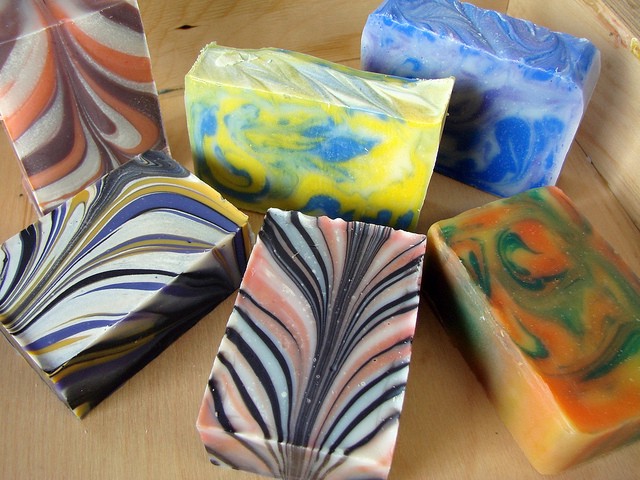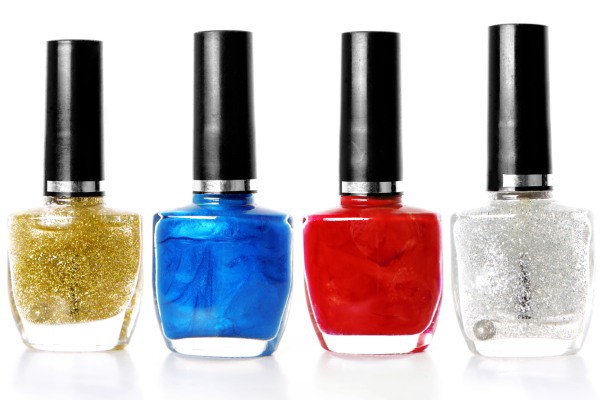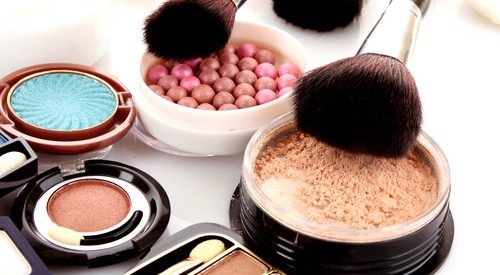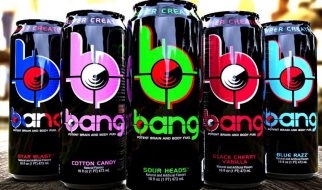The guide to colorants used in cosmetic products, related regulations and possible health risks.
You’ve probably noticed that apart from Latin names of ingredients many of your cosmetic products, especially makeup, contain ?CI 42090, CI 73360, etc? at the end of ingredients lists. If you have US-based products chances are you’ve seen something like FD&C Yellow No. 5 or Yellow 5 Lake. In this post we will try to shed a light on numerous types of colorants used in cosmetics, on their labeling, on how they are regulated in different countries and what potential hazards are connected to certain types of colorants.
Cosmetic colorants are classified as either organic or inorganic. While you?d think organic colors would be the safest, they were actually originally called ?coal tar? because they were derived from coal sources. However, nowadays almost all organic colorants are synthetic and are available as either water soluble, oil soluble or insoluble (= Lakes) agents in all kinds of shades. Organic colors (lakes and dyes) are synthetic, chemically very complex molecules and are divided into various groups including indigoids, xanthenes, azos, nitros and others. Compared to inorganic colors, organic colors are available in a larger variety of shades. Since most organic pigments are soluble (either water or oil soluble), they can be utilized not only in solid makeup products (e.g. lipsticks), but also in aqueous products (e.g. nail lacquer, liquid makeups). Water soluble dyes are used for coloring soaps, lotions, creams, powders, salts, etc.

Unlike organic colorants, inorganic colorants are composed of insoluble metallic compounds derived from natural sources (e.g. china clay, carbon deposits), or are synthesized. Inorganic colors aren?t thought to pose the same kinds of health risks as organic colors, so don?t require certification. In addition to inorganic colors, natural materials used to color cosmetics, like carrot oil, beet extract and henna, are also considered ?safe? and are exempt from classification. In the category of decorative cosmetics, the majority of colors used are pigments. It is the inorganic pigments that are popular with cosmetics but are subject to purity levels of heavy metals and have to be approved by the EU (Directive 76/768/EEC) and the FDA for use in cosmetics. The following are inorganic pigments commonly used in makeup.
Iron Oxides (CI 77489, CI 77491, CI 77492, CI 77499) ? Three basic shades: black, yellow and red. Iron oxides are found in a wide array of cosmetic products from eye shadow to talcum powder ? even products that are marketed as natural or organic. That?s because they?re safe, although the iron oxide in cosmetics is made synthetically. Iron oxides are made in a lab for safety reasons since naturally produced varieties often contain impurities. Oxides formed in a natural, uncontrolled setting are often contaminated with heavy metals. This is an example of natural not always being safer. Iron oxides are gentle and non-toxic in cosmetic products placed on the surface of the skin; usually not irritating to the skin and aren?t known to be allergenic. Iron oxides typically don?t cause problems even for people with sensitive skin.
Chromium Dioxides ? Shades range from dull olive green, to a blue green, or bright green, finds use in most categories of cosmetic preparations but prohibited for use in lip products in the USA. For example, Chromium Oxide Green (CI 77288) is a flat, matte, medium green pigment. Used extensively in soap making as a non-bleeding color, used extensively as well in cosmetics to adjust hues in foundations, blushes, bronzers and similar products, when they conform to FDA specifications. In the USA it is approved for eyes and face products but not allowed for lip products. In the EU it?s approved for lips, eyes and face products.
Ultramarines (CI 77007) ? Shade ranges from bright blue to violet, pink and green. Ultramarines may be safely used for coloring cosmetics and personal care products, including products intended for use in the area of the eye, when they conform to FDA specifications. Ultramarines are not allowed to be used in lipstick in the USA. In Europe approved for use in all cosmetics without restriction.
Manganese Violet (CI 77742) is a violet pigment used in the formulation of makeup, hair coloring products, bath products, nail polish and skin care products. Manganese Violet may be safely used for coloring cosmetics and personal care products, including products intended for use on the lips and products intended for use in the area of the eye, when it conforms to FDA specifications.
Ferric Ferrocyanide or Iron Blue (CI 77510) In cosmetics and personal care products, is used in the formulation of makeup, hair coloring products, bath products, nail polish and skin care products; this very deep intense dark blue pigment is widely used in all cosmetic applications. It is not permitted in lip products in the USA. Ferric ferrocyanide may be used in externally applied cosmetics in addition to lip area use in the EU and Japan.

White Pigments White pigments are widely used in all cosmetics. Titanium Dioxide and Zinc Oxide are the most commonly used in cosmetics.
- Titanium Dioxide (CI 77891) ? Titanium Dioxide is used to impart a whiteness to color cosmetics and personal care products that are applied to the skin (including the eye area), nails, lips, and it helps to increase the opacity, and reduce the transparency of a product formula. Titanium Dioxide is an important ingredient used in sunscreen products. Titanium dioxide is listed as a safe pigment, with no known adverse effects when used in cosmetics, and approved by the FDA when 99% pure. It is not listed as a carcinogen, mutagen, teratogen, comedogen, toxin or as a trigger for contact dermatitis. Titanium dioxide is not a cancer-causing substance unless exposure is beyond safe limits during manufacturing using this substance.
- Zinc Oxide (CI 77947) ? Zinc Oxide, a white powder, is used in a wide range of cosmetics and personal care products including makeup, nail products, baby lotions, bath soaps and foot powders. Zinc Oxide is also used in Over-the-Counter drug products such as skin protectants and sunscreen products. Zinc Oxide is safe for use in coloring products, including cosmetics and personal care products applied to the lips, and the area of the eye, provided it meets certain specifications.
Mica (CI 77019) ? Mica gives a natural translucence when used as face powders and powder blushers. Mica, is safe for use in coloring products, including cosmetics and personal care products applied to the lips, and the area of the eye.

Color additives are subject to more regulatory scrutiny in the US than they are in Europe. In Europe, for coloring agents use of INCI names is recommended. EEC directive mentions that coloring agents may be listed in any order after the other ingredients using the Colour Index (CI) Number. The official names for color additives in the USA are designated by the FDA. Cosmetic-grade dyes are labeled D&C, meaning they are approved for use in drugs and cosmetics. FD&C dyes are approved for food, drugs and cosmetics; as well as Ext. D&C for external drugs and cosmetics. This is followed by a color designation, such as blue or red, and by No. (for number), and by a numeral. An example of such a name is FD&C Red No. 40. Colors made by combining these ?straight? colors with ?substrates? (sodium, potassium, aluminum, barium, calcium strontium, or zirconium) are known as ?lakes? and are named using the same convention, but with the addition of the word lake and the substrate, for example: FD&C Red No. 40 Aluminum Lake. Also, often D&C and FD&C are left off the label, so instead you?ll see the colour listed like ?Blue 1 Lake.? Cosmetic colors that are not subject to batch certification are known by more common names, for example: Caramel or Henna.
Although certifications mean that colorants are rigorously tested, potential effects they may have with prolonged exposure are not always addressed . For example, many D&C and FD&C colors have been linked to allergic reactions, skin irritations, nervous system toxicity, reproductive system disruption and even cancer. For example, coal-tar-based dyes such as FD&C Blue 1 (CI 42090), most commonly found in toothpaste, and FD&C Green 3 (CI 42053), commonly found in mouthwash, have been found to be carcinogenic in animal studies when injected under skin.
All the Synthetically-enhanced colors may also contain heavy metal salts which can penetrate into the skin. It?s for this reason that many FD&C and D&C colors have been banned or withdrawn in some countries. Due to health risks only a handful of these color additives are still permitted, but it?s still a topic of hot debate. Although many manufacturers have started phasing out FD&C and D&C colours altogether, the reason why they?re still commonly found in foods and cosmetics is because their colours are generally more stable and consistent than natural dyes, easier to source and inexpensive.
If might be difficult to avoid them all, at least you can avoid these commonly listed troublemakers: Orange 5 (CI 45370); Orange 5 Lake (CI 45370); Red 4 (CI 14700); Red 6 (CI 15850); Red 6 Lake (CI 15850); Red 7 Lake (CI 15850); Red 21 (CI 45380); Red 21 Lake (CI 45380); Red 27 (CI 45410); Red 27 Lake (CI 45410); Red 30 Lake (CI 73360); Red 33 Lake (CI 17200); Blue 1 Lake (CI 42090); Blue 2 (CI 73015); Green 3 (CI 42053); Yellow 5 Lake (CI 19140); Yellow 6 Lake (CI 15985)
It would be impossible to remember all of these CI numbers so make sure to add these synthetic colors as personal alerts using CosmEthics to know when your cosmetic products contain them.
Stay Healthy!
CosmEthics Team
Download CosmEthics app for iOS in Europe.
Sources:
Cosmetics Info | The Science & Safety Behind Your Favorite Products
Cosmeticsinfo.org is an information Web site that includes factual, scientific information on ingredients most commonly?
cosmeticsinfo.org
Color Additives
Cosmetic Color Additives fall into two categories, Organic and Inorganic. ( Inorganic refers to the fact that they lack?
www.fromnaturewithlove.com
natural organic make-up – Titanium Dioxide: Toxic or Safe?
Kumazawa, et. al. in their study, “Effects of Titanium Ions and Particles on Neutrophil Function and Morphology?
www.organicmakeup.ca
Colors in Cosmetics: Regulation and Nomenclature in the United States
In the United States, with the exception of one class of hair dyes, all color additives for cosmetics must be?
www.personalcarecouncil.org
Iron Oxides Skincare Review – Pick Your Free Samples
Iron Oxides
Skincare Review – Pick Your Free Samples
Iron Oxideswww.skinstore.com
Cosmetic D&C and FD&C Colours – Are They Safe For Use In Makeup?
“Colours, like features, follow the changes of the emotions.” ~ Pablo Picasso It’s a known fact that humans are heavily?
alexamicosmetics.com
Image sources:


